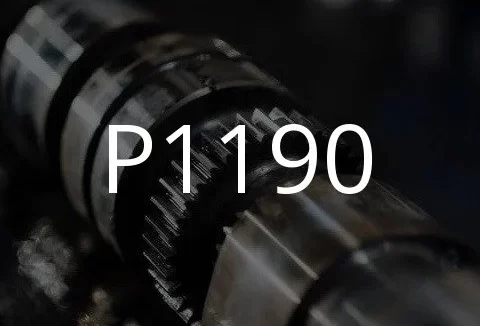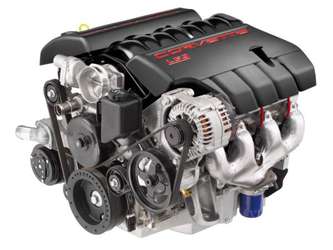
P1190 (Volkswagen, Audi, Skoda, Seat) Heated oxygen sensor (HO2S) 1, bank 1, reference voltage not reliable
Content
P1190 – OBD-II Trouble Code Technical Description
Trouble code P1190 indicates a problem with the heated oxygen sensor (HO2S) 1 bank 1 in Volkswagen, Audi, Skoda, Seat vehicles.
What does the fault code mean P1190?
Trouble code P1190 indicates a problem with the heated oxygen sensor (HO2S) 1, bank 1. This sensor measures the oxygen level in the exhaust gases and sends relevant information to the vehicle's engine control module (ECU). When a P1190 code is detected, the ECU usually indicates that there is a problem with the operation of that particular sensor, namely an unreliable reference voltage. Problems with the sensor (HO2S) or its circuit can result in an incorrect fuel/air mixture in the engine, which in turn can affect engine performance and emissions.

Possible reasons
Several possible reasons for the P1190 trouble code:
- Worn or damaged heated oxygen sensor (HO2S) 1, bank 1.
- Damage to the wiring or connections associated with the sensor (HO2S) 1.
- Incorrect reference voltage supplied to sensor (HO2S) 1.
- Problems with the engine control unit (ECU), including possible software errors or hardware failures.
- Problems with other engine management system components that may affect the operation of the (HO2S) 1 sensor, such as the mass air flow (MAF) sensor, coolant temperature sensor, or problems with the fuel injection system.
It is important to note that to accurately identify the cause, it is necessary to conduct additional diagnostics using specialized equipment and tools.
What are the symptoms of a fault code? P1190?
Symptoms associated with a P1190 trouble code can vary depending on the specific problem and vehicle characteristics, some of the possible symptoms are:
- check engine: One of the most common symptoms is the activation of the “Check Engine” light on your car’s dashboard.
- Loss of power: Incorrect fuel/air mixture caused by an unreliable heated oxygen sensor signal can result in loss of engine power.
- Unstable idle: If the fuel/air mixture is incorrect, the engine may idle rough, which may result in a shaking or rough running of the engine.
- Increased fuel consumption: An improper fuel/air mixture can result in increased fuel consumption due to inefficient engine operation.
- Unusual sounds or vibrations: Engine performance problems may also result in unusual sounds or vibrations while driving.
- Exhaust problems: Inaccurate data from the oxygen sensor can lead to increased emissions of harmful substances in the exhaust gases, which may attract the attention of inspection inspectors or lead to problems with passing compliance tests.
These symptoms may appear differently depending on the model and condition of the vehicle.
How to diagnose a fault code P1190?
Diagnosis for DTC P1190 may include the following steps:
- Reading the error code: Using a diagnostic scan tool, you must read the P1190 fault code from the engine control module (ECU) memory.
- Checking wiring and connections: Inspect the wiring and connectors associated with the heated oxygen sensor (HO2S) 1 in bank 1. Make sure the wiring is not damaged and the connections are secure.
- Checking the reference voltage: Measure the reference voltage supplied to the heated oxygen sensor HO2S 1. Verify that the voltage is within manufacturer specifications.
- Checking the HO2S Sensor: Test the HO2S 1 heated oxygen sensor using a multimeter or specialized equipment. Verify that the sensor is functioning correctly and is transmitting correct data.
- Checking other systems: Perform additional tests and diagnostics on other engine management system components such as the Mass Air Flow (MAF) sensor, coolant temperature sensor, and others to rule out possible problems affecting HO2S 1 sensor performance.
- Clearing the error code: After diagnosing and repairing faults, it is necessary to clear the error code from the memory of the engine control module using a diagnostic scanner.
If the above steps do not help identify the problem, it is recommended that you contact a professional auto mechanic or auto repair shop for more detailed diagnosis and repair.
Diagnostic errors
When diagnosing DTC P1190, the following errors may occur:
- Incorrect interpretation of error code: Sometimes mechanics may misinterpret the meaning of the P1190 error code, which can lead to incorrect actions to correct the problem.
- Insufficient checking of wiring and connections: Incomplete or superficial inspection of wiring and connections can lead to undiagnosed problems due to improper power or grounding of the HO2S sensor.
- HO2S sensor test failed: Incorrect testing of the heated oxygen sensor HO2S or misinterpretation of test results may lead to erroneous conclusions about its condition.
- Skip checking other systems: Some mechanics may limit themselves to diagnosing only the HO2S sensor without checking other engine management system components, which may result in missing other causes of the problem.
- Faulty replacement parts: Sometimes mechanics may replace the HO2S sensor without considering other possible causes of the P1190 code, which can result in unnecessary repair costs.
- Insufficient error code removal: After performing repair work, some mechanics may forget or skip the step of clearing the error code from the engine control module's memory, which may result in the error code constantly appearing even after the repair.
It is important to carry out diagnostics with due attention to each step and consider all possible causes of the problem in order to avoid errors and ensure effective troubleshooting.
How serious is the fault code? P1190?
Trouble code P1190 indicates a problem with the heated oxygen sensor (HO2S) 1, bank 1, which plays an important role in correcting the fuel/air mixture in the engine. Although this error in itself is not critical or emergency, its presence can lead to unstable engine operation, poor fuel economy and increased emissions of harmful substances.
A malfunctioning HO2S sensor can result in an incorrect fuel/air mixture, which can result in loss of power, increased fuel consumption, and other negative effects on engine performance and emissions.
Although individual cases of P1190 may be relatively mild and may not have a significant impact on the vehicle's performance, it is recommended to resolve the issue as soon as possible to avoid more serious consequences and maintain optimal engine performance and efficiency. Therefore, it is recommended to contact a specialist for diagnosis and repair when this error occurs.
What repair will help eliminate the code? P1190?
Troubleshooting trouble code P1190 may include the following steps:
- Heated Oxygen Sensor (HO2S) Replacement: If the HO2S 1 sensor in bank 1 is indeed found to be faulty or not functioning correctly as a result of diagnostics, replacement may be necessary. The new sensor must be installed and connected correctly.
- Checking and replacing wiring and connections: If the problem is due to damaged wiring or connections, they will need to be replaced or repaired. Poor connections or broken wiring can cause P1190.
- Checking and correcting the reference voltage: If the cause of the error is due to incorrect reference voltage, it must be checked and corrected. This may include checking power to the HO2S sensor and troubleshooting power or grounding issues.
- Additional diagnostics and repairs: If the problem is not resolved by replacing the HO2S sensor or repairing the wiring, additional diagnostics may be required on other engine management system components such as the mass air flow (MAF) sensor, fuel injection system, or engine control module (ECU). Repair or replacement of these components may be necessary to completely eliminate the problem.
- Clearing the error code: After performing repair work, it is necessary to clear the error code P1190 from the memory of the engine control module using a diagnostic scanner.
It is important to carry out all necessary repairs according to the manufacturer's recommendations and, if necessary, contact a qualified technician or auto mechanic for diagnosis and repair.

